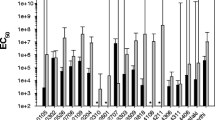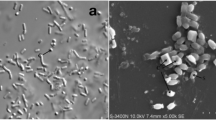Abstract
We have isolated a strain of Bacillus thuringiensis (Bt) from Indian soil samples that was shown to be toxic to Achaea janata larvae. The isolate, named B. thuringiensis DOR4, serotypically identified with the standard subspecies kurstaki (H3a3b3c) and produced bipyramidal inclusions along with an amorphous type. Although the plasmid pattern of DOR4 was different from that of the reference strain, a crystal protein profile showed the presence of two major bands (130 and 65 kDa) similar to those of Bt subsp. kurstaki HD-1. To verify the cry gene content of DOR4, triplex PCR analysis was performed; it showed amplification of the cry1C gene in addition to cry1Aa, cry1Ac, cry2A, and cry2B genes, but not the cry1Ab gene. RT-PCR analysis showed the expression of cry1Aa and cry1Ac genes. In vitro proteolysis of DOR4 protoxin with midgut extract generated products of different sizes. Zymogram analysis of DOR4 protoxin as substrate pointed to a number of distinct proteases that were responsible for activation of protoxins. Furthermore, toxin overlay analysis revealed the presence of multiple toxin-binding proteins in midgut epithelium. Based on all these characterizations, we suggest that the Bt DOR4 strain can be exploited for an A. janata control program.



Similar content being viewed by others
References
Aronson A (1995) The protoxin composition of Bacillus thuringiensis insecticidal inclusions affects solubility and toxicity. Appl Environ Microbiol 61:4057–4060
Baum JA, Malvar T (1995) Regulation of insecticidal crystal protein production in Bacillus thuringiensis. Mol Microbiol 18:1–12
Budatha M, Meur G, Dutta-Gupta A (2007) Identification and characterization of midgut proteases in Achaea janata and their implications. Biotechnol Lett 30:305–310
Budatha M, Meur G, Dutta-Gupta A (2007) A novel aminopeptidase in the fat body of the moth Achaea janata as a receptor for Bacillus thuringiensis Cry toxins and its comparison with midgut aminopeptidase. Biochem J 405:287–297
del Rincon-Castro MC, Barajas-Huerta J, Ibarra JE (1999) Antagonism between Cry1Ac1 and Cyt1A1 toxins of Bacillus thuringiensis. Appl Environ Microbiol 65:2049–2053
Garcia-Carreno FL, Dimes LE, Haard NF (1993) Substrate-gel electrophoresis for composition and molecular weight of proteinases or proteinaceous proteinase inhibitors. Anal Biochem 214:65–69
Juarez-Perez VM, Ferrandis MD, Frutos R (1997) PCR-based approach for detection of novel Bacillus thuringiensis cry genes. Appl Environ Microbiol 63:2997–3002
Karumbaiah L, Oppert B, Jurat-Fuentes JL, Adang MJ (2007) Analysis of midgut proteinases from Bacillus thuringiensis-susceptible and -resistant Heliothis virescens (Lepidoptera: Noctuidae). Comp Biochem Physiol B Biochem Mol Biol 146:139–146
Lee MK, Curtiss A, Alcantara E, Dean DH (1996) Synergistic effect of the Bacillus thuringiensis toxins CryIAa and CryIAc on the gypsy moth, Lymantria dispar. Appl Environ Microbiol 62:583–586
Lightwood DJ, Ellar DJ, Jarrett P (2000) Role of proteolysis in determining potency of Bacillus thuringiensis Cry1Ac delta-endotoxin. Appl Environ Microbiol 66:5174–5181
Masson L, Erlandson M, Puzstai-Carey M, Brousseau R, Juarez-Perez V, Frutos R (1998) A holistic approach for determining the entomopathogenic potential of Bacillus thuringiensis strains. Appl Environ Microbiol 64:4782–4788
Milne R, Kaplan H (1993) Purification and characterization of a trypsin-like digestive enzyme from spruce budworm (Choristoneura fumiferana) responsible for the activation of delta-endotoxin from Bacillus thuringiensis. Insect Biochem Mol Biol 23:663–673
Ogiwara K, Indrasith LS, Asano S, Hori H (1992) Processing of delta-endotoxin from Bacillus thuringiensis subsp. kurstaki HD-1 and HD-73 by gut juices of various insect larvae. J Invertebr Pathol 60:121–126
Oppert B, Kramer KJ, Johnson D, Upton SJ, McGaughey WH (1996) Luminal proteinases from Plodia interpunctella and the hydrolysis of Bacillus thuringiensis CryIA(c) protoxin. Insect Biochem Mol Biol 26:571–583
Sayyed AH, Gatsi R, Ibiza-Palacios MS, Escriche B, Wright DJ, Crickmore N (2005) Common, but complex, mode of resistance of Plutella xylostella to Bacillus thuringiensis toxins Cry1Ab and Cry1Ac. Appl Environ Microbiol 71:6863–6869
Schnepf E, Crickmore N, Van Rie J, Lereclus D, Baum J, Feitelson J, Zeigler DR, Dean DH (1998) Bacillus thuringiensis and its pesticidal crystal proteins. Microbiol Mol Biol Rev 62:775–806
Valadares De Amorim G, Whittome B, Shore B, Levin DB (2001) Identification of Bacillus thuringiensis subsp. kurstaki strain HD1-Like bacteria from environmental and human samples after aerial spraying of Victoria, British Columbia, Canada, with Foray 48B. Appl Environ Microbiol 67:1035–1043
Acknowledgments
This work was partly supported by a research grant from the Department of Biotechnology (DBT), the Government of India (Sanction No. BT/PR2745/AGR/02/141/2001). MB and GM are recipients of a fellowship from the Council for Scientific and Industrial Research (CSIR), India.
Author information
Authors and Affiliations
Corresponding author
Rights and permissions
About this article
Cite this article
Budatha, M., Meur, G., Vimala Devi, P.S. et al. Characterization of Bacillus thuringiensis Strain DOR4 Toxic to Castor Semilooper Achaea janata: Proteolytic Processing and Binding of Toxins to Receptors. Curr Microbiol 57, 72–77 (2008). https://doi.org/10.1007/s00284-008-9155-3
Received:
Accepted:
Published:
Issue Date:
DOI: https://doi.org/10.1007/s00284-008-9155-3




